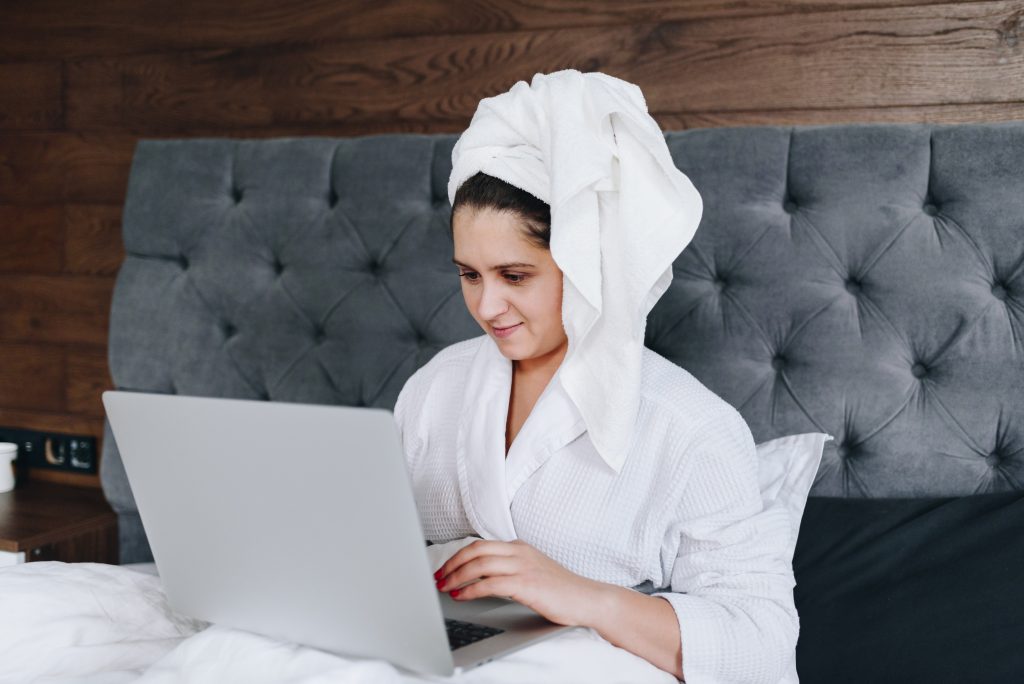
My Top Tips For- How To Be Comfortable Working From Home
Covid-19 has meant working from home for so many people. During this pandemic I have been using Video Consultations which has allowed me to see people in their homes and look at their positions whilst working. This has been a revelation, and I now know that most of you are sitting very badly even when you think you are not!
Many times it has not been difficult or expensive to completely change a position for the better and solve a lot of pain and stiffness with a few tweaks to a chair, positioning of the monitor or table height.
So if you are working from home squashed at the kitchen table, sitting in bed or maybe just not moving for hours check my tips below.
1. Check your seating position.
Sit at a table, on a chair that provides good back support (dining chairs are not ideal for the long term) but if it is the only option add cushions to get as much support as possible.
Aim to sit with your knees lower than your hips -consider an angled seat cushion, lumbar cushion or possibly if space and budget allows an alternative stool/office chair will be better than a four legged chair.
2. Where are your arms?
Make sure that your forearms are horizontal when typing and you have space to support the arms on the table surface, use a cushion to increase seat height if necessary. A wrist rest will ease the strain on your hands.
3. Your Feet
Make sure your feet are supported, on the floor or use a box/ footrest if necessary. Swap feet on the box regularly.
4. Laptop/Monitor height.
Examine the height of your screen so that you keep your head balanced, avoid tilting your head forward to look at the screen (this adds stress to the upper back and neck) experiment by using books, magazines or reams of paper.
With your laptop raised you will need a separate keyboard and mouse. Laptop, monitor stands and separate keyboards and mice are readily available.
5. Consider a sitting/standing desk
Alternating between sitting and standing is great for your back and the general rule is 1:1 1:2 standing versus sitting for comfort and energy levels.
Adjust your desk and screen for your height. Your desk should align with your elbows, while the top of the screen should be at eye level.
Don’t forget to think of your wrists , they should be slightly more extended (tilted backwards)when standing. In order to protect them always keep your keyboard and mouse at the same level, and your wrists straight when typing.
If you still experience sore wrists on occasion, consider an adjustable keyboard stand and gel mouse pads for optimal support.
Furthermore attaching an arm support to your desk can help with shoulder and neck problems, especially on the side of your dominant hand.
Wellness top tips
Keep moving –If you are working from home you can stand and walk around when you are on the phone. Try standing and working for short periods Maybe you can work for short periods at your kitchen worktop with your laptop raised on a box -making sure that your forearms are horizontal when you type. Your neck posture is not ideal when working like this but for periods of 5 to 10 minutes it can help you ease strain on your lower back.
Take frequent breaks– Working at home can mean sitting for longer because there are less distractions –
Try to keep your physical work area separate from home life– Aim to stick to clear start and finish times to avoid work merging into home-life time.
Things to definitely avoid doing-
- Working with your laptop on your lap, on a soft chair / sofa – There is more potential for neck pain and back pain if you do this. If it is unavoidable, make sure you put a firm cushion behind your lower back and try to raise your laptop on a folder etc. to increase its height slightly.
- Sitting at breakfast bar stools – these often do not provide good foot support or lower back support.
- Working in bed – physically and psychologically this is not a good idea.
Photo by Anastasiia Chepinska on Unsplash